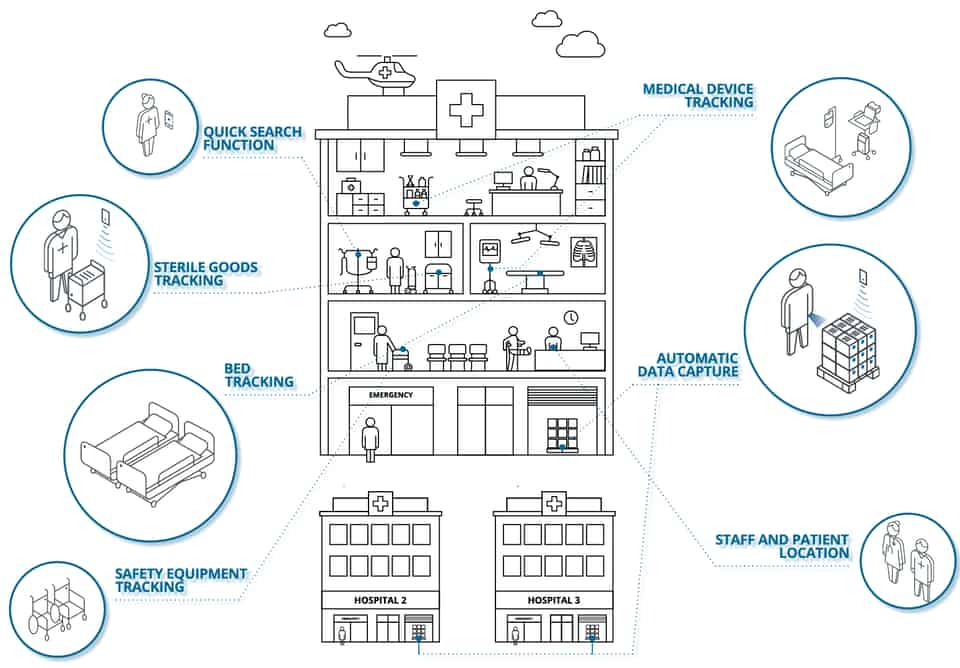A need for better
healthcare logistics
Let’s start with an analogy. Have you ever been running out of the front door and suddenly realised you have no idea where your purse, wallet, car keys or other assorted daily must-haves are? It’s frustrating isn’t it, especially when in a rush. Now, think about this in a busy hospital scenario, replacing the purse, wallet and keys with a myriad of hospital equipment, from beds to life-saving medical devices – struggling to locate them could be pretty stressful. Finally, think how transformative it would be to be able to locate these items immediately. That’s where X-Tracking™ comes in. At Lyngsoe Systems, we’ve developed a solution that uses RFID technology to fix this exact problem. Well, the medical challenge, we can’t help you find your car keys!
Operational challenges commonly faced by hospitals is handled effectively with X-Tracking
For busy hospitals in the current climate, logistics is more critical than ever to ensure they can deliver a more efficient and, most importantly, safe service for patients. Not being able to locate the correct medical device at the point of need, be it an infusion pump, syringe driver, patient hoist or dynamic mattress, can have a profoundly negative impact – not only on the medical staff and patient with the immediate requirement, but also on the wider operations of the entire hospital.
The first issue – medical staff must spend valuable time searching for the required item if it can’t be found at the point of need. This impacts time and, in turn, cost. Then comes the effects it may have on patient care and safety. Not having the correct tools for the job runs the risk of the cancellation of appointments and treatments, and could be, at worst, life threatening.
Add to this the inability to maintain an asset if you don’t know where it is – some devices may miss their scheduled maintenance dates and risk being used when faulty, causing further threats to patient safety. The challenges don’t stop there. Think about time-consuming procurement processes to replace medical devices that already exist but are simply lost, growing patient wait times and the impact on patient flow – the problems start to become a black hole of inefficiency and risk.
Now let’s consider some of these core challenges with real-world examples. Nursing staff on average spend 21 minutes locating equipment during every shift, hospitals generally spend 25% more on equipment than required due to poor location data and NHS Trusts have had hundreds of mattresses missing at any one time.* There must be a solution to help mitigate some of these challenges.

Benefits of using RFID technology in healthcare
The lasting impact of RFID technology in healthcare
It’s clear that being able to easily locate medical equipment in a hospital can not only save time and money, but it can significantly improve patient safety and care. Today’s hospitals are fast-paced, high-stress environments and the situation is worsening – 44% of NHS staff reported feeling unwell as the result of work-related stress in 2020 (up from 40% in 2019).** An RFID solution like X-Tracking™ can be truly transformative for operational efficiencies and, if it goes some way to helping alleviate stress for hospital staff, we are even prouder of our innovation.
Discover X-Tracking in use
How RFID supports asset tracking
Discover how RFID plays a key part in a fit for purpose, efficient asset tracking solution, helping you streamline your organization and ensure the highest levels of asset visibility.
Bridging industries - From Healthcare to the Wider Supply Chain
Discover how our healthcare expert, Andy James, is taking his hospital and healthcare X-Tracking™ experience and applying it to the wider supply chain.
The integral role of RTLS in healthcare digital transformation
Real time tracking solutions are playing an integral part in the healthcare sector’s continual move to digital platforms alongside their digital transformation initiatives. Learn more.
RFID vs. BLE: competition or collaboration
Greater than the sum of their parts, RFID and BLE technologies become an unstoppable force when combined to support a diverse range of sectors. Learn more now.
Improving patient outcomes with RFID
A force for good – how RFID tracking technology solutions are revolutionizing the healthcare industry and positively impacting patient outcomes. Learn more now.
Delivering excellence with GS1 certified solutions
Lyngsoe X-Tracking™ Solution is recertified by GS1, whilst Automated Validation Station (AVS) and Lyngsoe LIVE Logistics™ solutions become GS1 certified.
Become a frontrunner
Contact us today and lets revolutionize healthcare together